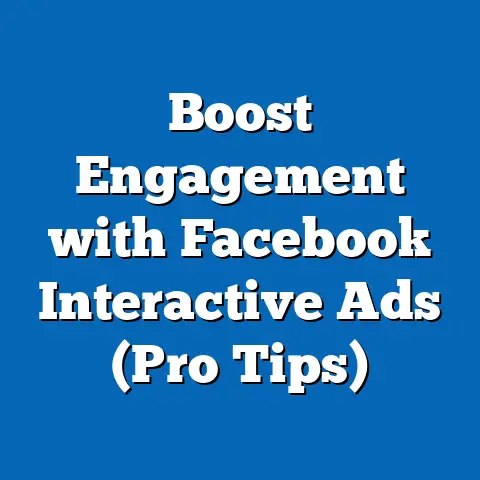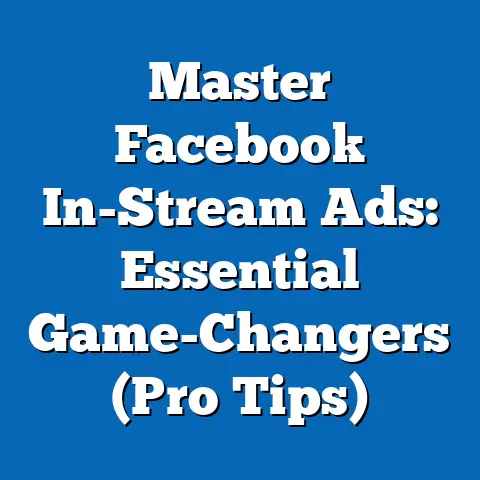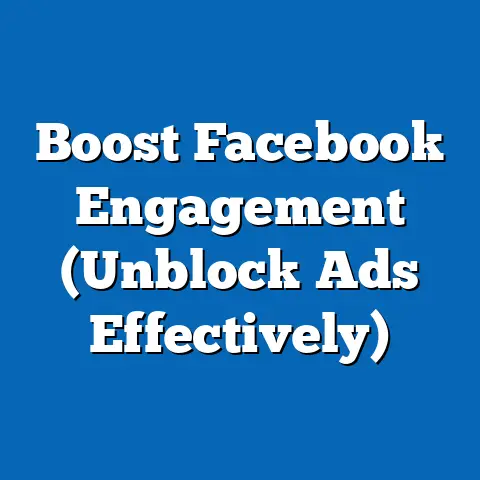Fix Invalid Parameter in Facebook Ads (Expert Solutions)
In the ever-evolving world of digital marketing, we often encounter paradoxes. For instance, in a space designed to connect businesses with their audiences, why do so many ads find themselves lost in translation, riddled with errors that prevent them from reaching their intended destination? I’ve seen this happen time and time again, even with seasoned marketers. One of the most frustrating issues I’ve come across is the “invalid parameter” error in Facebook Ads.
Facebook Ads have become a cornerstone of modern digital marketing. They offer unparalleled reach and sophisticated targeting capabilities, allowing businesses to connect with potential customers in ways that were unimaginable just a decade ago. But the power of Facebook Ads comes with complexity. A single, seemingly minor error can derail an entire campaign, leading to wasted ad spend and missed opportunities.
Understanding Facebook Ads
Before we dive into the specifics of invalid parameters, let’s take a step back and review the fundamentals of Facebook advertising.
1.1 Overview of Facebook Advertising
Facebook Ads are a powerful tool for businesses of all sizes. They allow you to target specific demographics, interests, and behaviors, ensuring that your message reaches the people most likely to be interested in your products or services.
Here’s why Facebook Ads are so effective:
- Massive Reach: With billions of active users, Facebook offers an unparalleled reach for your advertising campaigns.
- Granular Targeting: Facebook’s advanced targeting options allow you to narrow your audience based on demographics, interests, behaviors, and even custom audiences derived from your own customer data.
- Diverse Ad Formats: From simple image ads to engaging video ads and interactive lead forms, Facebook offers a variety of ad formats to suit your marketing goals.
- Measurable Results: Facebook Ads Manager provides detailed analytics and reporting, allowing you to track your campaign performance and optimize your strategy for maximum ROI.
I remember when I first started using Facebook Ads for a small e-commerce business. The ability to target customers based on their specific interests – in this case, a love for vintage clothing – was a game-changer. Within weeks, we saw a significant increase in website traffic and sales.
However, the power of Facebook Ads comes with responsibility. You need to understand how to use the platform effectively and avoid common pitfalls, such as invalid parameter errors.
1.2 The Importance of Parameters in Ads
Parameters are essentially the instructions that tell Facebook where to send users when they click on your ad. They are the invisible strings that connect your ad to your website or landing page. Without the right parameters, your ad is like a car without a steering wheel – it might look good, but it won’t get you where you need to go.
Here are some key types of parameters used in Facebook Ads:
- UTM Parameters: These are tracking codes that you add to your URLs to track the source, medium, and campaign of your traffic in Google Analytics. They are crucial for understanding which ads are driving the most valuable traffic to your website.
- Targeting Parameters: These are the settings you define in Facebook Ads Manager to target your desired audience. They include demographics, interests, behaviors, and custom audiences.
- Dynamic Parameters: These parameters allow you to dynamically insert information into your ad copy, such as the user’s name or location. This can help personalize your ads and increase engagement.
When I’m setting up a new campaign, I always make sure to meticulously track my UTM parameters. It’s not enough to just launch an ad and hope for the best. You need to know exactly where your traffic is coming from so you can optimize your campaigns for maximum ROI. I’ve seen firsthand how accurate tracking can make or break a campaign.
Identifying Invalid Parameters
Now that we understand the importance of parameters, let’s discuss how to identify when something is wrong.
2.1 Common Types of Invalid Parameters
Invalid parameters can take many forms, but here are some of the most common types I’ve encountered:
- Typos: A simple typo in your URL or parameter code can render the entire ad invalid.
- Incorrect Formatting: Parameters need to be formatted correctly, with the right syntax and delimiters. For example, using the wrong type of quotation marks or forgetting an ampersand (&) can cause an error.
- Unsupported Characters: Certain characters, such as spaces or special symbols, are not allowed in URLs and parameters.
- Missing Parameters: Sometimes, the issue is not that the parameter is incorrect, but that it’s missing altogether. For example, if you’re using dynamic parameters, you need to make sure that all the required parameters are present.
- Incorrect Values: The values you assign to your parameters also need to be valid. For example, if you’re targeting a specific age range, you need to make sure that the values you enter are within the acceptable range.
I once spent hours troubleshooting an ad campaign because of a single, tiny typo in a UTM parameter. It was a frustrating experience, but it taught me the importance of meticulous attention to detail.
2.2 Signs of Invalid Parameters
So, how do you know when your ad has invalid parameters? Here are some telltale signs:
- Error Messages: Facebook Ads Manager will often display an error message indicating that there is an issue with your parameters. These messages can be cryptic, but they usually provide a clue as to what’s wrong.
- Ad Disapproval: If your ad is disapproved, it could be due to invalid parameters. Check the ad status in Ads Manager for more information.
- Low Performance: If your ad is running, but you’re seeing unusually low click-through rates or conversion rates, it could be a sign that there’s a problem with your parameters.
- Tracking Issues: If your Google Analytics data doesn’t match your Facebook Ads data, it could indicate that your UTM parameters are not working correctly.
- Broken Links: If users are clicking on your ad but landing on a broken page, it’s a clear sign that there’s an issue with your URL.
When I see an ad with low click-through rates, the first thing I do is check the URL and parameters. It’s often the simplest things that cause the biggest problems. I’ve learned to always start with the basics.
Causes of Invalid Parameter Errors
Now that we know how to identify invalid parameters, let’s explore the underlying causes.
3.1 Technical Issues
Sometimes, invalid parameter errors are caused by technical glitches that are beyond your control.
- API Integration Problems: If you’re using a third-party tool to manage your Facebook Ads, there could be issues with the API integration. This can lead to parameters being corrupted or lost during the transfer of data.
- Platform Bugs: Facebook, like any software platform, can have bugs that cause unexpected errors. These bugs can sometimes affect the way parameters are processed.
- Server Issues: If your website’s server is experiencing problems, it could affect the way URLs are resolved, leading to invalid parameter errors.
I remember one instance where a Facebook Ads campaign I was managing suddenly started generating invalid parameter errors. After hours of troubleshooting, I discovered that it was a bug in the Facebook Ads API. It was frustrating, but it taught me that sometimes, the problem is not on your end.
3.2 User Errors
More often than not, invalid parameter errors are caused by simple user errors.
- Copy-Pasting Errors: Copy-pasting URLs from one place to another can introduce errors, especially if you’re not careful. Make sure to double-check the URL after you paste it to ensure that it’s correct.
- Manual Entry Errors: Manually typing URLs and parameters is prone to errors. It’s easy to make a typo or forget a character.
- Misunderstanding Parameter Requirements: Facebook has specific requirements for how parameters should be formatted. If you don’t understand these requirements, you’re more likely to make mistakes.
I’m guilty of making these errors myself. I’ve learned to slow down and pay attention to detail when entering URLs and parameters. It’s better to spend a few extra minutes verifying your work than to waste hours troubleshooting errors later.
3.3 Platform Changes
Facebook is constantly evolving, and its advertising policies and formats are subject to change. These changes can sometimes lead to unexpected invalid parameter errors.
- Policy Updates: Facebook may update its advertising policies to restrict certain types of parameters or values.
- Format Changes: Facebook may change the way URLs and parameters are processed, which can break existing ads.
- New Features: The introduction of new features can sometimes introduce compatibility issues with existing parameters.
It’s important to stay up-to-date on Facebook’s advertising policies and best practices. This will help you avoid surprises and ensure that your ads are always compliant. I make it a habit to check the Facebook Ads Help Center regularly for updates.
Expert Solutions to Fix Invalid Parameters
Now that we understand the causes of invalid parameter errors, let’s discuss how to fix them.
4.1 Double-Check Your URLs
The first step is to carefully double-check your URLs for errors. This may seem obvious, but it’s often the most effective solution.
- Verify Spelling: Make sure that all the words in your URL are spelled correctly.
- Check for Typos: Look for any typos, such as extra characters or missing characters.
- Confirm Formatting: Ensure that the URL is formatted correctly, with the right syntax and delimiters.
- Use a URL Validator: There are many online tools that can help you validate your URLs. These tools will check for common errors and ensure that your URL is properly formatted.
One of my favorite tools for validating URLs is the URL Decoder/Encoder. This tool allows you to encode and decode URLs, which can help you identify any special characters that might be causing problems.
4.2 Correcting Parameter Formatting
If your URL is correct, the next step is to check the formatting of your parameters.
- Use the Correct Syntax: Parameters should be added to your URL using the following syntax:
?parameter1=value1¶meter2=value2. - Encode Special Characters: Special characters, such as spaces or symbols, should be encoded using URL encoding. For example, a space should be encoded as
%20. - Use the Correct Delimiters: Parameters should be separated by an ampersand (&).
- Avoid Unsupported Characters: Certain characters, such as angle brackets (< and >), are not allowed in URLs and parameters.
I always keep a cheat sheet of URL encoding codes handy. It’s a simple tool, but it can save you a lot of time and frustration.
4.3 Utilizing Facebook’s Debugging Tools
Facebook provides several debugging tools that can help you diagnose and fix invalid parameter errors.
- Sharing Debugger: This tool allows you to preview how your URL will look when shared on Facebook. It can also help you identify any errors in your URL or parameters.
- Ads Manager: Ads Manager provides detailed information about your ad campaigns, including any errors that may be preventing your ads from running.
- Facebook Pixel Helper: This Chrome extension helps you troubleshoot issues with your Facebook Pixel, which can sometimes be related to invalid parameters.
The Sharing Debugger is my go-to tool for troubleshooting URL issues. It’s a quick and easy way to identify any problems with your URL or parameters.
4.4 Testing and Monitoring Ads
The best way to avoid invalid parameter errors is to test your ads thoroughly before launching them.
- Test Your URLs: Click on your ad’s URL to make sure that it leads to the correct page.
- Monitor Your Ad Performance: Keep a close eye on your ad’s performance, especially in the first few days after launching it. If you see any signs of invalid parameter errors, take action immediately.
- Use A/B Testing: A/B testing can help you identify any issues with your ads before you roll them out to a larger audience.
I always create a small test campaign before launching a full-scale ad campaign. This allows me to identify and fix any errors before they can impact my results.
Advanced Techniques for Prevention
In addition to fixing invalid parameter errors, it’s also important to take steps to prevent them from happening in the first place.
5.1 Automating Parameter Management
One of the best ways to prevent user errors is to automate the management of your ad parameters.
- Use a UTM Builder: There are many online tools that can help you build UTM parameters automatically. These tools can help you avoid typos and ensure that your parameters are formatted correctly.
- Use a Spreadsheet Template: Create a spreadsheet template for managing your ad parameters. This will help you keep track of your parameters and ensure that they are consistent across all of your ads.
- Use a Third-Party Tool: There are many third-party tools that can help you manage your Facebook Ads, including your ad parameters. These tools can automate many of the tasks involved in managing your ads, which can help you reduce the risk of errors.
I use a UTM builder for all of my ad campaigns. It’s a simple tool, but it saves me a lot of time and helps me avoid errors.
5.2 Training and Resources for Teams
If you’re working with a team, it’s important to provide them with the training and resources they need to understand Facebook Ads and parameter handling.
- Create a Training Manual: Develop a training manual that covers all aspects of Facebook Ads, including parameter handling.
- Provide Ongoing Training: Provide ongoing training to your team to keep them up-to-date on the latest Facebook Ads policies and best practices.
- Encourage Collaboration: Encourage your team to collaborate and share their knowledge. This will help them learn from each other and avoid making the same mistakes.
I’ve found that providing my team with clear guidelines and ongoing training is the best way to prevent errors and ensure that our ad campaigns are always performing at their best.
5.3 Regular Updates and Best Practices
Facebook is constantly evolving, so it’s important to establish a routine for staying updated on the latest Facebook Ads policies and best practices.
- Check the Facebook Ads Help Center Regularly: The Facebook Ads Help Center is a valuable resource for staying up-to-date on the latest policies and best practices.
- Follow Industry Blogs and Forums: There are many industry blogs and forums that cover Facebook Ads. These resources can help you stay informed about the latest trends and best practices.
- Attend Industry Conferences: Attending industry conferences is a great way to network with other marketers and learn about the latest Facebook Ads strategies.
I make it a habit to spend a few hours each week reading industry blogs and forums. This helps me stay on top of the latest trends and best practices.
Case Studies
To illustrate the importance of understanding and fixing invalid parameters, let’s look at a few real-world case studies.
6.1 Real-World Examples of Invalid Parameter Issues
- Case Study 1: E-Commerce Business: An e-commerce business launched a Facebook Ads campaign to promote a new product line. However, they accidentally included a typo in their URL, which led to a broken link. As a result, they wasted a significant amount of ad spend and missed out on potential sales.
- Case Study 2: Lead Generation Company: A lead generation company launched a Facebook Ads campaign to collect leads for a new service. However, they failed to encode a special character in their URL, which prevented the ad from tracking conversions correctly. As a result, they were unable to accurately measure the ROI of their campaign.
- Case Study 3: Local Restaurant: A local restaurant launched a Facebook Ads campaign to promote a special offer. However, they used an unsupported character in their URL, which caused the ad to be disapproved. As a result, they missed out on the opportunity to attract new customers.
These case studies highlight the importance of paying attention to detail and avoiding common errors when setting up your Facebook Ads campaigns.
6.2 Success Stories After Fixing Invalid Parameters
- Success Story 1: Online Retailer: An online retailer was struggling to generate sales from their Facebook Ads campaign. After carefully reviewing their URLs and parameters, they discovered that they had made a typo in their UTM parameters. Once they fixed the typo, their sales increased by 20%.
- Success Story 2: Software Company: A software company was seeing low click-through rates on their Facebook Ads campaign. After using the Sharing Debugger, they discovered that their URL was not properly formatted. Once they corrected the formatting, their click-through rates doubled.
- Success Story 3: Marketing Agency: A marketing agency was managing a Facebook Ads campaign for a client. After noticing that their Google Analytics data did not match their Facebook Ads data, they discovered that they had forgotten to include UTM parameters in their URLs. Once they added the UTM parameters, they were able to accurately track the performance of their campaign.
These success stories demonstrate the positive impact that fixing invalid parameters can have on your Facebook Ads campaigns.
Understanding and fixing invalid parameters is crucial for enhancing the effectiveness of your Facebook Ads. By paying attention to detail, using the right tools, and staying up-to-date on the latest policies and best practices, you can avoid these errors and maximize your ROI.
So, take action today to refine your Facebook advertising strategies. Double-check your URLs, correct your parameter formatting, utilize Facebook’s debugging tools, and test and monitor your ads. By doing so, you can ensure that your ads are always reaching their intended destination and delivering the results you expect.
Don’t let invalid parameters derail your Facebook Ads campaigns. Take control of your advertising strategy and unlock the full potential of this powerful platform. Your success is within reach.






